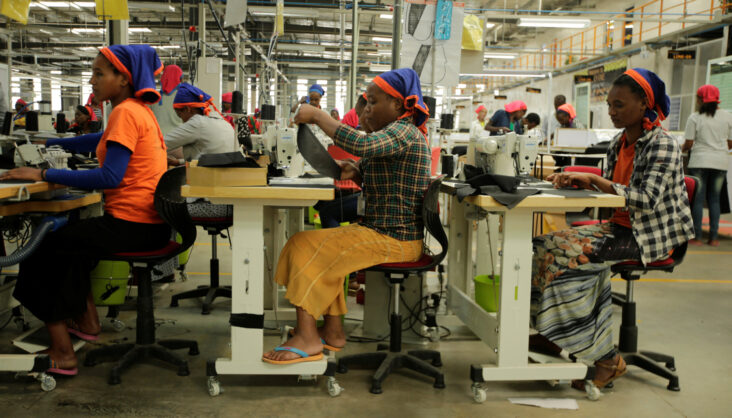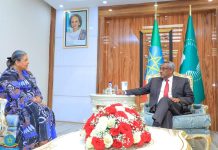
Africa-Press-Ethiopia
Home to seven million inhabitants, Ethiopia’s Tigray region has been unstable since November of 2020 following the first military operation to root out Tigray People’s Liberation Front (TPLF) rebels. Although armed operations are technically over, economic instability persists. How has this affected Ethiopia’s overall economy?
Ethiopia is going through its worst economic shock in decades due to the combined impact of Covid-19 and the conflict in Tigray. But nonetheless, the economy was still on pace to grow in 2020.
The Tigray conflict emerged when the TPLF leadership contested Prime Minister Abiy Ahmed’s authority. He responded by removing the TPLF from power in Tigray.
According to the World Bank, Ethiopia’s economy grew at an average 9.8% rate from 2008 to 2019. The effects of the Covid-19 pandemic on the economy, coupled with the conflict in the northern Tigray region, lowered growth projections.
The IMF also predicted a major slowdown for 2020, with growth dropping to 1.9%, which would be the lowest rate of growth for Ethiopia since since 2003. The World Bank’s estimates are rosier, with a growth rate of 6.3% for the 2020 fiscal year.
Ratings agency Fitch says: “We do expect more of a hit to growth in FY21 than FY20, but forecast a return to growth rates in the 6%-7% range over the medium term.
Manufacturing and losses
Tigray is home to an important portion of the country’s manufacturing and mining activity. The conflict in Tigray has had a ripple effect on the rest of Ethiopia.
The region hosts 5,120 small, medium, and large manufacturing enterprises, according to a paper published in December 2020, entitled The State of Manufacturing Infrastructure and Business Environment in Tigrai: Challenges and Recommended Policies.
Africa Insight
Wake up to the essential with the Editor’s picks.
Email Address
Also receive offers from The Africa Report
Also receive offers from The Africa Report’s partners
There is one industrial park close to the regional capital, Mekelle, that specialises in textiles. Another is in the works: the Baeker Integrated Agro-Industrial Park.
In the aftermath of the conflict, Indian company SCM Knit Tex, which operates in Mekelle, noted that the Tigray factory did not suffer damage because the industrial park was protected by the federal army.
Several international investors are also present in the region, including Velocity Apparelz (UAE), DBL (Bangladesh) and Indochine Apparel (China). Management sources close foreign companies, who asked not to be named, confirmed damages to their factories though did not elaborate on details to The Africa Report.
Others have been more vocal, such as Alaa Al Saqati, head of the Egyptian Industrial Zone in Ethiopia. He said in late 2020 that Egyptian investments in Tigray Region were around $10m. Speaking to The Africa Report on his behalf, Doaa Mansour confirmed losses of $2m.
Saqati will be representing a group of Egyptian investors seeking compensation for their losses. Mansour adds: “We are going to arbitration for the losses. We invested in furniture manufacturing and also electric transformers. As there is no activity, our clients are not paying us.”
Though no law firm has yet been chosen and the process is still ongoing, Ethiopia ratified the New York Convention on the Recognition and Enforcement of Foreign Arbitral Awards in February of 2020. The commissioner of the Ethiopian Investment Commission, Lelise Neme, stated in December 2020 that it had begun “efforts towards resolving problems faced by investors in the Tigray region and get them back to operation very soon”.
Even in an unstable situation, the country has attractive advantages: one of the lowest wages in the world for textile manufacturing ($26/month in 2019), 8-10 years of income-tax exemptions, no taxes on most exports and land leases with zero charges over a period of 60 to 80 years.
The country’s preferential trade agreements with the US (African Growth and Opportunities Act) and the EU (Everything But Arms) have been incentives for textile manufacturers, mainly from South-East Asia. This “saves 9.6% in costs that would be paid if clothes were made in India” says Arul Saravanan, chief marketing officer of SCM Garments.
Soil rich for agriculture and mining
Prior to Prime Minister Abiy’s rise to power in 2018, Ethiopia had been following a developmental state model. Economic planning through the government’s Growth and Transformation Plans: GTP I (2010-2015) and GTP II (2015-2020) targeted a transition to an export-oriented and industry-based economy.
The Tigray Region is the second-largest producer of sesame seeds in the country. According to data from the trade and industry ministry, “about 44% of the national sesame seed production comes from Amhara Region, followed by Tigray (31%)”.
In 2018, oily seeds – such as sesame– accounted for $363m in exports for Ethiopia, ranking it as the world’s third-largest producer. But since November, there has been “supply disruption as a result of the fighting in the region”, the Ethiopian Commodity Exchange reported in January.
Tigray’s mineral resources have also attracted foreign investment to explore for “gold, base metals, industrial minerals, coal, gemstones, and other ores and minerals,” according to a study entitled Mining Sector Challenges in Developing Countries, Tigray, Ethiopia and Inspirational Success Stories from Australia.
However, 60%-80% of minerals are mined by artisanal producers, while 80%-95% are mined artisanally for construction minerals like basalt, pumice and limestone, as Rahel Getachew, senior programme officer at Canadian International Resources and Governance Institute, told Africa Mining Market.
But with the arrival of mining companies Altus Strategies (Great Britain), ASCOM (Egypt) and Newmont (USA) – all focused on gold – those figures are likely to change, especially since Tigray is the largest producer of gold, with Ethiopia’s gold exports representing $145m in the 2019-2020 budget year.





